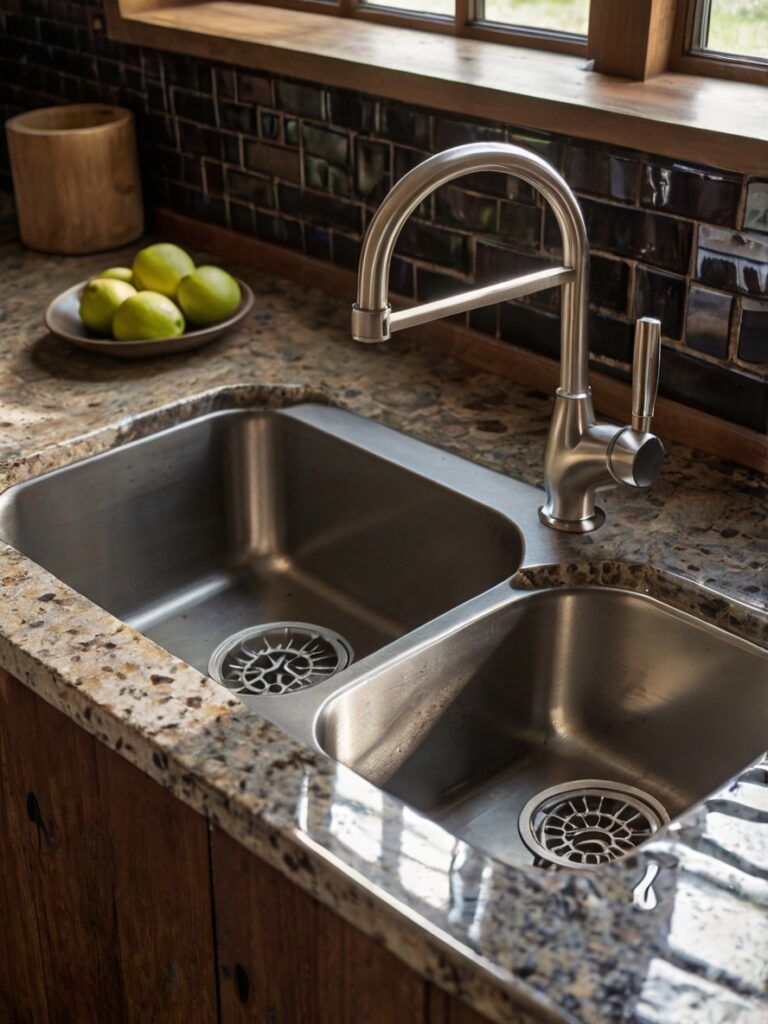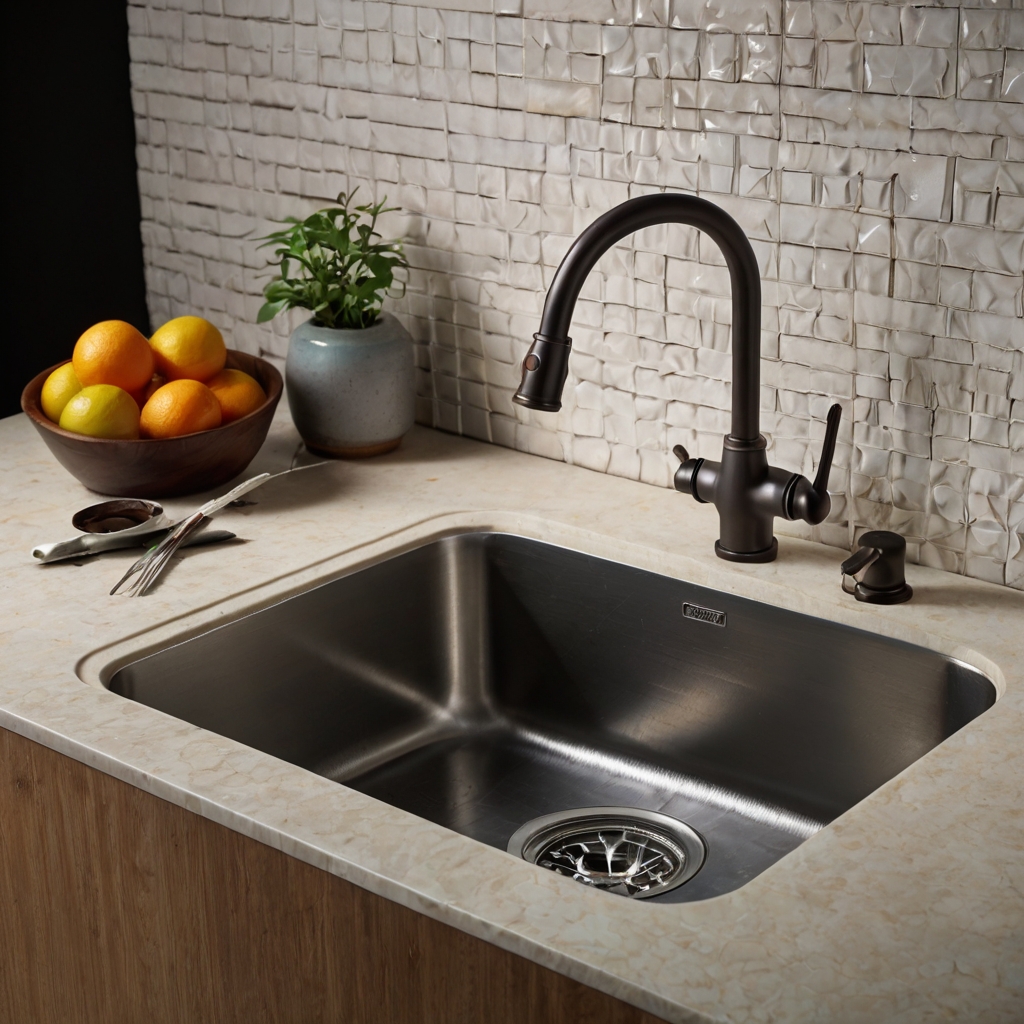kitchen sink is one of the most important elements in any kitchen. Whether you’re remodeling your kitchen or designing one from scratch, choosing the right sink can make a huge difference in both the functionality and aesthetics of your space. From washing dishes to preparing food, the kitchen sink is a central hub of activity, so it’s essential to choose one that fits your lifestyle and complements your kitchen design.
In this comprehensive guide, we’ll explore everything you need to know about kitchen sinks—from the different styles and materials available to essential installation tips and maintenance advice. By the end, you’ll have all the information you need to select the perfect sink for your kitchen.
Why Is the Kitchen Sink So Important?
The kitchen sink is much more than a place to wash dishes; it’s a vital workstation in the kitchen. Whether you’re rinsing vegetables, filling pots with water, or cleaning up after a meal, your kitchen sink plays a critical role in your daily kitchen tasks. A good sink not only needs to be durable and practical but also should seamlessly fit into the overall design of your kitchen.
Types of Kitchen Sinks
There are several different types of kitchen sinks available, each offering unique benefits and styles. The type you choose will depend on factors like the size of your kitchen, the layout of your counters, and your personal preferences. Let’s explore the most popular types of kitchen sinks:

1. Undermount Sinks
Undermount sinks are installed beneath the countertop, creating a seamless look with no visible edges or seams. This design makes it easy to wipe food and water directly into the sink without any lip obstructing the way.
Pros:
- Sleek, modern appearance
- Easy to clean and maintain
- Maximizes countertop space
Cons:
- Can be more expensive to install
- Requires a sturdy countertop (e.g., granite, quartz)
Best For: Homeowners who prefer a minimalist look and have solid countertops.
2. Top-Mount or Drop-In Sinks
Top-mount sinks, also known as drop-in sinks, are installed by dropping the sink into a pre-cut hole in the countertop. The rim of the sink rests on the counter, making installation straightforward.
Pros:
- Easier and cheaper to install
- Compatible with a variety of countertop materials
- Ideal for DIY projects
Cons:
- The raised lip can collect debris
- Less streamlined appearance
Best For: Budget-conscious homeowners or those looking for an easy-to-install option.
3. Farmhouse or Apron-Front Sinks
Farmhouse sinks are known for their large, deep basins and exposed front, which extends past the edge of the countertop. They are ideal for washing large pots and pans and add a classic, rustic charm to the kitchen.
Pros:
- Spacious basin for large tasks
- Stylish, timeless design
- Works well in both modern and traditional kitchens
Cons:
- Can be more expensive
- Requires custom cabinetry for installation
Best For: Those looking for a statement piece and a functional, deep sink for heavy-duty kitchen tasks.
4. Double-Bowl Sinks
Double-bowl sinks have two separate compartments, which are perfect for multitasking—one bowl for washing and the other for rinsing, drying, or soaking.
Pros:
- Allows for multiple tasks at once
- Can separate washing from food prep
Cons:
- Takes up more counter space
- Smaller individual bowl sizes compared to single-bowl sinks
Best For: Homeowners who prefer versatility and multitasking in the kitchen.
5. Single-Bowl Sinks
Single-bowl sinks consist of one large basin, which is perfect for those who need plenty of space to wash large items, such as baking sheets or stockpots.
Pros:
- More space for larger dishes
- Simple and clean design
- Easier to fit into compact kitchens
Cons:
- Less flexibility for multitasking
- Cannot separate dirty dishes from food prep
Best For: People with smaller kitchens or those who prioritize sink space for large items.
6. Corner Sinks
Corner sinks are designed to fit into the corner of a kitchen, maximizing counter space. They are often found in smaller kitchens or in unique layouts where space is limited.
Pros:
- Space-saving solution for small kitchens
- Can free up counter space
Cons:
- Less practical for multitasking
- Typically smaller in size
Best For: Compact kitchens where space is at a premium.
Kitchen Sink Materials
Choosing the right material for your kitchen sink is crucial for its durability, maintenance, and overall look. Here’s a breakdown of the most popular kitchen sink materials:
1. Stainless Steel
Stainless steel is one of the most popular materials for kitchen sinks due to its durability, affordability, and modern appearance. It’s resistant to rust and corrosion and easy to clean.
Pros:
- Durable and long-lasting
- Affordable
- Matches most kitchen appliances
Cons:
- Can scratch and dent over time
- Noisy when washing dishes
Best For: Homeowners who want a low-maintenance, budget-friendly option with a sleek look.
2. Cast Iron (Enamel-Coated)
Cast iron sinks are coated with a thick layer of enamel, giving them a smooth and glossy finish. They are incredibly durable and available in a variety of colors to match any kitchen decor.
Pros:
- Extremely durable and heavy-duty
- Available in various colors
- Heat-resistant
Cons:
- Very heavy (requires strong cabinetry)
- Can chip or scratch over time
Best For: Those who want a colorful, sturdy sink that can stand the test of time.
3. Granite Composite
Granite composite sinks are made from a blend of granite stone and resin, making them highly durable and resistant to stains, scratches, and heat. They come in a variety of colors and finishes, making them a stylish addition to modern kitchens.
Pros:
- Extremely durable and resistant to scratches and stains
- Stylish appearance with a stone-like finish
- Heat-resistant
Cons:
- Can be more expensive
- Requires careful cleaning to avoid damage
Best For: Homeowners looking for a durable, stylish sink that complements a modern kitchen.
4. Fireclay
Fireclay sinks are made from molded ceramic clay that’s fired at high temperatures, resulting in a hard, durable surface. They are typically found in farmhouse-style sinks and offer a timeless look.
Pros:
- Beautiful, classic design
- Resistant to stains and scratches
- Available in various colors
Cons:
- Heavy and requires sturdy cabinetry
- Can chip if heavy objects are dropped into the sink
Best For: Those looking for a high-end, traditional sink with a smooth, elegant finish.
5. Copper
Copper sinks add warmth and a unique, rustic charm to kitchens. Over time, the surface develops a patina that adds character. Copper is naturally antibacterial, making it a hygienic option for the kitchen.
Pros:
- Antibacterial properties
- Unique and stylish appearance
- Develops a natural patina over time
Cons:
- Can be expensive
- Requires regular maintenance to preserve the finish
Best For: Homeowners who want a distinctive, antique look and are willing to invest in upkeep.
Factors to Consider When Choosing a Kitchen Sink
Now that you know the different styles and materials available, here are a few additional factors to consider when choosing your kitchen sink:
1. Size
The size of your sink depends on the size of your kitchen and the amount of counter space available. Measure the area where your sink will be installed and consider your daily needs. Larger sinks are great for multitasking, but smaller ones might be more practical for compact kitchens.
2. Mounting Style
Choose between undermount, top-mount, or apron-front sinks based on your countertop type and the aesthetic you’re going for. Each mounting style has its pros and cons, so be sure to select one that fits your design and functional needs.
3. Number of Bowls
Do you prefer a single, large basin or the flexibility of a double-bowl sink? Consider how you use your sink daily. If you often juggle multiple tasks, a double-bowl sink may be more practical. If you need room for washing large items, a single-bowl sink might be the better option.
4. Faucet Compatibility
Make sure your sink is compatible with your faucet, especially if you’re choosing a drop-in sink. You’ll need to ensure there are enough pre-drilled holes to accommodate your faucet and any accessories like soap dispensers or side sprayers.
Maintenance Tips for Your Kitchen Sink
To keep your sink looking and functioning at its best, regular maintenance is essential. Here are a few maintenance tips based on sink material:
- Stainless Steel: Clean with mild dish soap and a soft cloth to prevent water spots and maintain shine.
- Cast Iron: Avoid abrasive cleaners to prevent scratching the enamel coating.
- Granite Composite: Use a non-abrasive cleaner and avoid harsh chemicals to preserve the finish.
- Copper: Use a copper cleaner to maintain the shine, or let it age naturally for a patina look.
Conclusion
Choosing the perfect kitchen sink involves balancing style, functionality, and durability. By considering the various styles, materials, and installation options, you can select a sink that not only fits your design aesthetic but also meets your daily needs. Whether you prefer the sleek look of stainless steel, the classic appeal of a farmhouse sink


You might also like
Uncategorized
Honey Roasted Carrots with Garlic, Lemon, and Thyme: A Perfectly Sweet and Savory Side Dish
Uncategorized
Crispy Homemade French Fries Recipe — Golden, Crunchy, and Irresistible!
Uncategorized
Homemade Goldfish Crackers: A Fun and Cheesy Snack You’ll Love